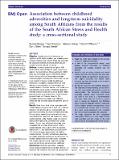| dc.contributor.author | Bruwer, Belinda | en_US |
| dc.contributor.author | Govender, Ravi | en_US |
| dc.contributor.author | Bishop, Melanie | en_US |
| dc.contributor.author | Williams, David R | en_US |
| dc.contributor.author | Stein, Dan J | en_US |
| dc.contributor.author | Seedat, Soraya | en_US |
| dc.date.accessioned | 2014-07-07T17:01:33Z | |
| dc.date.issued | 2014 | en_US |
| dc.identifier.citation | Bruwer, Belinda, Ravi Govender, Melanie Bishop, David R Williams, Dan J Stein, and Soraya Seedat. 2014. “Association between childhood adversities and long-term suicidality among South Africans from the results of the South African Stress and Health study: a cross-sectional study.” BMJ Open 4 (6): e004644. doi:10.1136/bmjopen-2013-004644. http://dx.doi.org/10.1136/bmjopen-2013-004644. | en |
| dc.identifier.issn | 2044-6055 | en |
| dc.identifier.uri | http://nrs.harvard.edu/urn-3:HUL.InstRepos:12406542 | |
| dc.description.abstract | Objective: Suicide and suicidal behaviours are significant public health problems and a leading cause of death worldwide and in South Africa. We examined the association between childhood adversities and suicidal behaviour over the life course. Methods: A national probability sample of 4351 South African adult participants (aged 18 years and older) in the South African Stress and Health (SASH) study was interviewed as part of the World Mental Health Surveys initiative. Respondents provided sociodemographic and diagnostic information, as well as an account of suicide-related thoughts and behaviours. Suicidality or suicidal behaviour were defined as were defined as suicide attempts and suicidal ideation in the total sample, and suicide plans and attempts among ideators. Childhood adversities included physical abuse, sexual abuse, parental death, parental divorce, other parental loss, family violence, physical illness and financial adversity. The association between suicidality and childhood adversities was examined using discrete-time survival models. Results: More than a third of the respondents with suicidal behaviour experienced at least one childhood adversity, with physical abuse, parental death and parental divorce being the most prevalent adversities. Physical abuse, sexual abuse and parental divorce were identified as significant risk markers for lifetime suicide attempts, while physical abuse and parental divorce were significantly correlated with suicidal ideation. Two or more childhood adversities were associated with a twofold higher risk of lifetime suicide attempts. Sexual abuse (OR 9.3), parental divorce (OR 3.1) and childhood physical abuse (OR 2.2) had the strongest associations with lifetime suicide attempts. The effect of childhood adversities on suicidal tendencies varied over the life course. For example, sexual abuse was significantly associated with suicide attempts during childhood and teen years, but not during young and later adulthood. Conclusions: Childhood adversities, especially sexual abuse, physical abuse and parental divorce, are important risk factors for the onset and persistence of suicidal behaviour, with this risk being greatest in childhood and adolescence. | en |
| dc.language.iso | en_US | en |
| dc.publisher | BMJ Publishing Group | en |
| dc.relation.isversionof | doi:10.1136/bmjopen-2013-004644 | en |
| dc.relation.hasversion | http://www.ncbi.nlm.nih.gov/pmc/articles/PMC4067829/pdf/ | en |
| dash.license | LAA | en_US |
| dc.subject | MENTAL HEALTH | en |
| dc.subject | PSYCHIATRY | en |
| dc.title | Association between childhood adversities and long-term suicidality among South Africans from the results of the South African Stress and Health study: a cross-sectional study | en |
| dc.type | Journal Article | en_US |
| dc.description.version | Version of Record | en |
| dc.relation.journal | BMJ Open | en |
| dash.depositing.author | Williams, David R | en_US |
| dc.date.available | 2014-07-07T17:01:33Z | |
| dc.identifier.doi | 10.1136/bmjopen-2013-004644 | * |
| dash.contributor.affiliated | Williams, David | |


